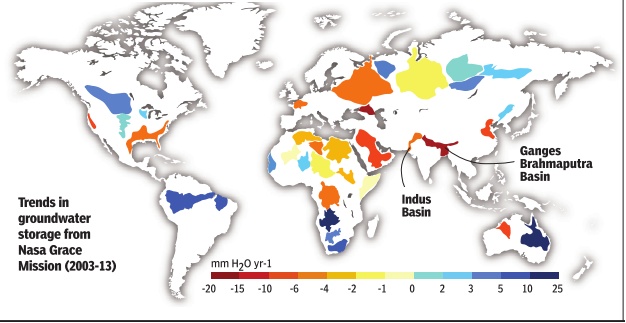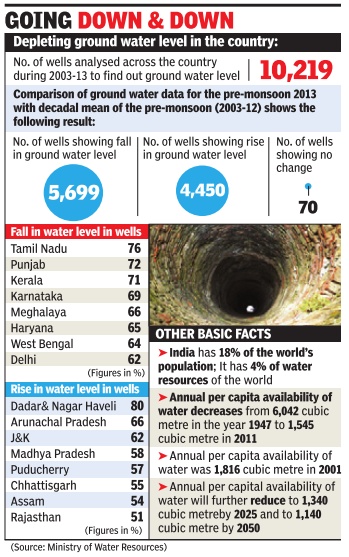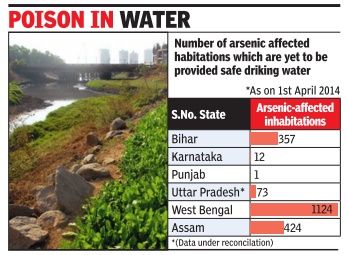Groundwater: India
| Line 16: | Line 16: | ||
[[File: ground water.jpg| |frame|500px]] | [[File: ground water.jpg| |frame|500px]] | ||
[http://epaperbeta.timesofindia.com/Article.aspx?eid=31808&articlexml=Depleting-ground-water-levels-cause-for-worry-27072014014025 The Times of India ] Jul 27 2014 | [http://epaperbeta.timesofindia.com/Article.aspx?eid=31808&articlexml=Depleting-ground-water-levels-cause-for-worry-27072014014025 The Times of India ] Jul 27 2014 | ||
| − | |||
Ground water levels in various parts of India are declining as the country could not adequately recharge aquifers in deficit areas where it has been used for irrigation, industries and drinking water needs of the growing population over the years. | Ground water levels in various parts of India are declining as the country could not adequately recharge aquifers in deficit areas where it has been used for irrigation, industries and drinking water needs of the growing population over the years. | ||
| Line 45: | Line 44: | ||
The report has recommended that a national task force be set up on a time-bound basis that will work on mission mode on the issue that affects people, plants, animals and all else around it. The committee has also recommended for a central fund allocation for the purpose. At a press conference, Joshi said, the Centre cannot escape its responsibility to provide safe, potable water to 7 crore Indians which is there fundamental right. | The report has recommended that a national task force be set up on a time-bound basis that will work on mission mode on the issue that affects people, plants, animals and all else around it. The committee has also recommended for a central fund allocation for the purpose. At a press conference, Joshi said, the Centre cannot escape its responsibility to provide safe, potable water to 7 crore Indians which is there fundamental right. | ||
| + | |||
| + | =India and the world= | ||
| + | [http://epaperbeta.timesofindia.com//Article.aspx?eid=31808&articlexml=PUTTING-INDIA-ON-THE-MAP-28062015019032 ''The Times of India''] | ||
| + | [[File: groundwater india and the world.jpg|Groundwater: India and the world; Graphic courtesy: [http://epaperbeta.timesofindia.com//Article.aspx?eid=31808&articlexml=PUTTING-INDIA-ON-THE-MAP-28062015019032 ''The Times of India'']|frame|500px]], Jun 28 2015 | ||
| + | |||
| + | About 13 of the world's 37 biggest aquifers, including two in India, are being seriously depleted by irrigation and other uses, much faster than they can be recharged by rain or runoff. There were 21 major groundwater basins -in red, orange, and yellow -that lost water faster than they could be recharged between 2003 and 2013.Sixteen major aquifers (in blue) by contrast, gained water during that period. | ||
=See also= | =See also= | ||
[[Groundwater: India]]/ | [[Groundwater: India]]/ | ||
[[Water Resources: India (ministry data)]]/ [[Water Economy: India]] | [[Water Resources: India (ministry data)]]/ [[Water Economy: India]] | ||
Revision as of 16:11, 30 June 2015
This is a collection of articles archived for the excellence of their content.
|
Contents |
Depleting groundwater
Depleting ground water levels cause for worry
Vishwa.Mohan New Delhi
The Times of India Jul 27 2014
Ground water levels in various parts of India are declining as the country could not adequately recharge aquifers in deficit areas where it has been used for irrigation, industries and drinking water needs of the growing population over the years.
The Central Ground Water Board (CGWB) has told the ministry of water resources that around 56% of the wells, which are analyzed to keep a tab on ground water level, showed decline in its level in 2013 as compared to the average of preceding 10 years (200312) period.
The CGWB, a government agency , came to this conclusion by analyzing 10,219 wells across the country . It found that 5,699 wells had reported decline during that period. It also concluded that agriculture sector is the biggest user of water followed by domestic and industrial sector.
Sharing the Board's data, the ministry of water resources had last week told the Lok Sabha that the ground water was continuously being exploited due to population growth, increased industrialization and irrigation.
“As a result, ground water levels in various parts of the country are declining... The state governments have been advised to take suitable remedial measures to check ground water exploitation and ensure recharge of aquifers in water stressed areas“, said the MoS for water resources, Santosh Gangwar, in his written response to a question.
Depleting ground water level may be a real worry if one looks at the future demand of water in India. It is estimated that the country would need 1,180 billion cubic meter (BCM) of water annually by 2050. India has, at present, annual potential of 1,123 BCM of `utilizable' water with 690 BCM coming from surface water resources and remaining 433 BCM from ground water resources. In view of this projection, the country would not be able to meet its demand unless it recharges its aquifers and uses water more efficiently and judiciously. The government has decided to set up a National Bureau of Water Use Efficiency under its `National Water Mission' to promote water conservation in a big way , keeping in mind the future requirement.
The CGWB has, on its part, recently signed a memorandum of understanding (MoU) with Indian Institute of Remote Sensing to facilitate a collaborative study “to assess the impact of ground water abstraction“ in India.
Arsenic in groundwater
Mohua Chatterjee, December 12, 2014
The parliamentary estimates committee headed by BJP MP Murli Manohar Joshi, in its first report on arsenic in groundwater, has criticized the Centre for “neglecting“ the serious issue that impacts at least 7 crore people across six states, according to CSIR estimates (data from different ministries and departments on the subject varies widely , the committee found). The panel has recommended that the Centre take up the issue on war footing through a national task force that can work on mission-mode from collating date to taking remedial measures to providing for health care to affected people. The committee has suggested that the issue be dealt with at the central level, instead of asking states alone to tackle the problem. Joshi said, “To say water is a state is sue is no logic, given the scale of the problem, the Centre cannot escape its responsibility to provide safe drinking water for 7 crore people, which is their fundamental right.” He was speaking at a press conference after the report was tabled.
The report has recommended that a national task force be set up on a time-bound basis that will work on mission mode on the issue that affects people, plants, animals and all else around it. The committee has also recommended for a central fund allocation for the purpose. At a press conference, Joshi said, the Centre cannot escape its responsibility to provide safe, potable water to 7 crore Indians which is there fundamental right.
India and the world

About 13 of the world's 37 biggest aquifers, including two in India, are being seriously depleted by irrigation and other uses, much faster than they can be recharged by rain or runoff. There were 21 major groundwater basins -in red, orange, and yellow -that lost water faster than they could be recharged between 2003 and 2013.Sixteen major aquifers (in blue) by contrast, gained water during that period.
See also
Groundwater: India/ Water Resources: India (ministry data)/ Water Economy: India

